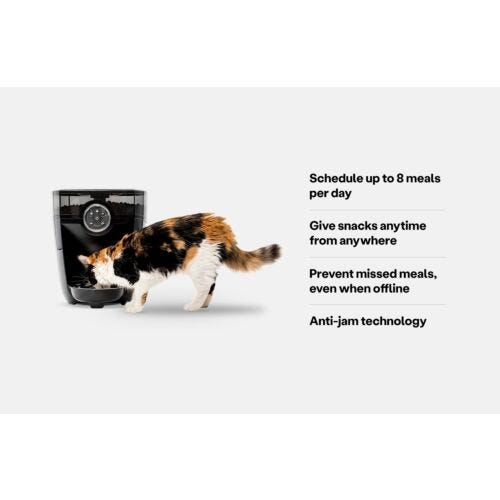One of the scariest moments a pet parent might face is realizing that their furry family member is missing. July is National Lost Pet Prevention Month: Learn why you should microchip your pet and read our 12 tips for how to find a lost cat. Be persistent and don’t lose hope!
Reminder: Microchip your cat
Microchipping is a sure way to drastically increase your chances of finding a lost pet. According to Petfinder.com, the return-to-owner rate for microchipped cats is over 38% (compared to a heartbreaking 2% that aren’t microchipped).
Need a refresher on what microchipping is? This inexpensive device is a small, electronic chip enclosed in a glass cylinder about the size of a grain of rice that is inserted under your pet’s skin. It’s a radio-frequency identification (RFID) implant that contains a unique identification number. The number is linked to your information and stored in an online database. Learn more about common misconceptions when it comes to microchipping your pet.
Consider a breakaway collar with ID tags
Not all cats will permit themselves to be outfitted with a collar. But for those that do: make sure it’s a breakaway collar and consider attaching an unobtrusive ID tag to the collar. This tag should include your phone number, your home address (optional), and the fact that your cat is microchipped, if applicable. The tag can also have your cat’s name on it, but it’s unlikely they will come to their name when called by a stranger (as a dog might). If your cat has a relevant medical condition and the light-weight tag has space to specify so, you should.
How to find a lost cat

A majority of cats that escape outside do so through an open door or garage. Some also leave via a window or broken window screen, or even jump from a balcony. Be vigilant about open doors and windows in your home, including patio doors and those windows that are screened.
One study found that in the past five years, 75% of cats that went missing were reunited with their humans: “In this study, 59% of cats were found by looking in the neighborhood and 30% came home on their own; only 2% were found at the local animal control.”
Even if you’ve microchipped your cat and outfitted them with an ID tag, there are multiple strategies you can employ to take the matter into your own hands—without relying on the kindness of strangers who may or may not be able to catch your lost fur baby.
1. Make sure your cat isn’t hiding somewhere inside
This may seem totally obvious, but you should never underestimate a cat’s ability to discover new hiding places. Check cracks and crevices in the basement, recliners, cupboards, drawers, closets, loose ceiling tiles, under mattresses, inside your dryer, the list goes on! Fortunately, there’s a good chance your kitty is just an expert at concealing and not lost at all.
2. Shake treat bags and open canned cat food
If, however, you are certain you’ve scoured every accessible inch of your home, garage, and/or shed, and there’s no kitty to be found, take your search outside. If your cat is recently missing, there’s a good possibility they are close to home. Shake a bag of their favorite treats while calling for them, or open a can of their favorite wet food. (Or plug in your Feeder-Robot outside and serve a snack!) You can even record the noise of opening a can of wet food to have this enticing soundbite on hand as you walk around.
3. Set water and food in a cardboard box outside your door(s)
Your escaped cat may be feeling too vulnerable and overwhelmed to come to you when called. Set an empty cardboard box outside your exterior door(s) and place a bowl of food and fresh water inside. Not only will your kitty have access to the essentials, but they'll have a box to hide inside if they're feeling scared.

4. Check trees on your property
Look up: It sounds like a cliché, but cats do get stuck in trees! Check all the trees and bushes around your property, even the ones that appear uncomfortable to you. (Think pine trees, thorny bushes, and more.) Your cat could have followed a bird up a tree or a small critter into a bush. Or, they could have simply panicked and tried to find a protective natural enclosure.
5. Go door-to-door in your neighborhood
These days, most of us have an absurd amount of photos of our pets on our phones. Have a clear photograph of your cat ready to pull up on your phone and start walking the neighborhood. Show your neighbors the photograph and ask if they’ll allow you to search their property, including garages and sheds that your cat could have gotten into. Leave your contact info with them in case they spot your kitty later on.
6. Call local shelters, vet clinics, and animal control
Give a detailed description of your missing pet (or better yet, bring photocopies) to animal shelters, vet clinics, and animal control in your area . Let them know if your cat is microchipped. If a good samaritan decides to drop off your kitty, some of these locations may have the necessary microchip readers—or at the very least, they can contact you and let you know a cat of similar description has shown up.
7. Post your lost pet information on social media sites
In addition to the usual Facebook, Twitter, and Instagram, post your lost pet information to sites like TabbyTracker.com, Nextdoor.com, PetAmberAlert.com, Craigslist, and local online newspapers like Patch.
Contact the company your cat’s microchip is with. They may be able to send an email to their network alerting the local community of your cat’s description.
8. Post flyers in your and surrounding neighborhoods
Post flyers on utility poles in the surrounding neighborhoods and at as many local businesses as will allow. Flyers should include a color photo of your cat as well as your phone number. Brightly colored flyers tend to attract more attention. If possible, offer a reward as incentive.
9. Place a lost cat ad
Since not everyone is on social media, you can also try a more traditional route and place lost cat ads in your local newspapers. Call your local radio stations to see if they run free air spots for lost pets.
10. Set humane traps
Place a humane live trap, such as a Havahart, near your house with a bit of canned cat food inside. (If you don’t have one, check with your local shelter or animal control to see if they can rent you one.) Leave the live trap out overnight; you may end up with a raccoon instead of a cat, but it doesn’t hurt to try!
11. Search outside at night
Cats are usually crepuscular, which means your lost kitty could be stepping lively after dark. Head outside with a flashlight and can of cat food, preferably right after dark when the world has quieted down or right before sunrise. You may be able to spot your cat more easily because of the light reflecting off their eyes, or they may simply feel more comfortable approaching you in a calmer environment.
12. Don’t lose hope
Finally, don’t give up on your search for your cat. There are plenty of stories out there where cats have returned home weeks or even months after disappearing. Keep pounding the pavement around your neighborhood, checking in with shelters, and posting to relevant sites online. Chances are, your kitty is trying to get back to you as hard as you’re trying to find them. And many animal experts agree that cats have an incredible homing instinct, which means that they can perceive direction using something beyond the five ordinary senses of taste, smell, sight, touch, and hearing.
Keep these strategies for how to find a lost cat close, and microchip your cat for further peace of mind!
Sources:
Cover photo by niklas_hamann on Unsplash







